

Overview
During pre-production and production, an animator must collect, organize, and tag references according to how they inform the piece. The collection of references could be presented in a simple linear format organized by shot and element or in a more interactive dynamic format with each element linked to citations.
Presenting citations linked with content has several benefits. The creator of the visualization receives greater credibility. A viewer is able to determine the data behind elements and also have a list of resources for further investigation and learning. Different visualizations of similar subjects could more objectively be compared, and newer versions could be produced as further information is discovered. Not all formats would be suitable for every venue, so the output format must be tailored to the way viewers will ultimately access it. We anticipate further dialog around the reporting of reference use in scientific animation.
Suggested Use
Visualization designers can use this tool to annotate science animations with informative citations
CANVIS: Citation, Annotation & Visualization Integration System
Describing systematic methods for annotating science animations with informative citations
We can categorize various components of animations into elements and properties. These individual properties and elements can be tied to specific references and data sources. We can further specify how data was used: intact, filtered, or modified. There are a variety of ways in which an annotated animation and associated bibliography could be presented to audiences.

CANVIS Prototype UI
Designed by Savanna Jackson








